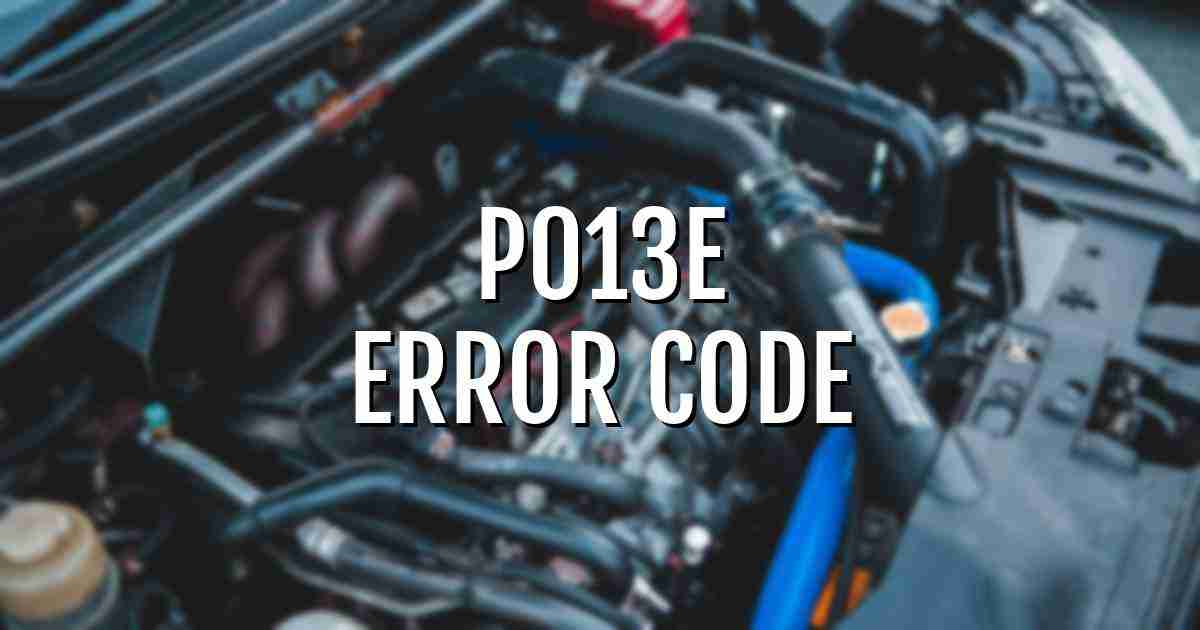OBD code P013E indicates a fault with Heated Oxygen Sensor Bank 1 Sensor 2 in the vehicle’s exhaust system.
Symptoms include the Engine Light ON, high fuel consumption, and excessive exhaust smoke.
Causes may include a faulty sensor, wiring issues, fuel system problems, or exhaust leaks.
This issue should be addressed promptly to prevent further damage.
A possible fix involves inspecting and repairing the sensor, wiring harness, and connectors for any damage or poor connections.
| Repair Importance Level | 6.67 (Out of 10) |
| Estimated Repair Time | Approximately 1.0 hour |
| Repair Difficulty Level | 6.67 (Out of 10) |
Symptoms of the p013e OBD Code
The vehicle may experience issues related to the oxygen sensor bank 1 sensor 2.
- When OBD code P013E occurs, symptoms may include: Engine Light ON.
- High Fuel Consumption.
- Excessive Smoke from Exhaust.
Causes of the p013e OBD Code
Do you know you can clear most fault codes—but some could mean serious danger? Don’t take chances with your safety or your family’s safety. This budget-friendly car scanner makes it easy to clear fault codes in seconds while showing you exactly what’s wrong. Plug it in, connect to your Android or iOS phone, and instantly check live data. You’ll know if it’s a minor issue you can clear or something serious that needs attention—so you can drive safely and stress-free. (Today’s Deal)
P013E code typically indicates an issue with the oxygen sensor delayed response.
- P013E can be caused by a Faulty Heated Oxygen Bank 1 Sensor 2.
- A Heated Oxygen Bank 1 Sensor 2 harness that is open or shorted.
- A Heated Oxygen Bank 1 Sensor 2 circuit with poor electrical connection.
- Low or high fuel system pressure.
- Fuel contamination.
- Faulty fuel injectors.
- Exhaust gas leaks.
- Or engine vacuum leaks.
Fixing Error Code p013e Step By Step
To resolve fault code P013E, inspect and potentially replace the oxygen sensor in bank 1 sensor 2.
- To fix OBDII code P013E, start by reviewing the possible causes mentioned above and visually examining the corresponding wiring harness and connectors.
- Ensure to check for any damaged components and inspect the connector pins for signs of being broken, bent, pushed out, or corroded.
- Next, test the oxygen sensor for proper operation and replace it if necessary.
- Clear the fault codes from the vehicle’s computer using a scan tool.
- Finally, test drive the vehicle to ensure the code does not return, indicating a successful repair.
Cost Of Fixing p013e Fault Code
Diagnosing and repairing fault code P013E may involve inspecting and replacing the oxygen sensor.
The cost to diagnose and fix OBD code P013E typically ranges from $75 to $150, with an estimated repair time of 1. 0 hour.
Costs depend on labor rates, complexity of the issue, and any additional parts needed for the repair.
That fault code is a turning point. If repair costs are climbing and your current loan feels like it’s holding you back, this is the time to plan ahead. The free Car Loan Payment Tracker helps you see how quickly you can pay off what’s left—and start preparing, with confidence, for your dream car.
Details of the p013e OBD Code
Fault code P013E relates to a problem with the oxygen sensor delayed response in bank 1 sensor 2.
OBD code P013E means O2 Sensor Delayed Response Rich to Lean Bank 1 Sensor 2. This code is triggered when the downstream oxygen sensor (sensor 2) in bank 1 takes too long to respond to changes in the airfuel mixture from rich to lean.
The ECM monitors this sensor to ensure the catalytic converter is functioning properly.
If the sensor response time is slow, it can indicate a potential issue with the catalytic converter or the sensor itself.
Mechanic’s Tech Notes
Detailed information on fault code P013E, including possible causes and diagnostic steps.
OBDII code P013E indicates a potential issue with the oxygen sensor delayed response richtolean bank 1 sensor 2. To diagnose, use a voltmeter to test the oxygen sensor’s signal wire for proper voltage changes during engine operation.
Check the sensor’s wiring harness and connector for any damage, corrosion, or loose connections.
Scan tools can help monitor sensor data and confirm proper sensor operation.
If the sensor responds slowly or inaccurately, replacing it may be necessary.
Ensure the new sensor is compatible with the vehicle’s make and model.
FAQ
OBD code P013E indicates an issue with Heated Oxygen Sensor Bank 1 Sensor 2. Symptoms include Engine Light ON, High Fuel Consumption, and Excessive Smoke.
Common symptoms for code P013E include Engine Light ON, High Fuel Consumption, Excessive Smoke from Exhaust. Causes may include faulty oxygen sensor or wiring issues.
Diagnose and repair OBD code P013E by checking Bank 1 Sensor 2, wiring, fuel system, and exhaust components for faults. Inspect connectors and wiring for damage or corrosion.

Wrap Up
If your check engine light is on and you’re experiencing issues with your vehicle’s fuel system, you may have OBDII code P013E.
This code typically indicates a problem with the oxygen sensor bank 1 sensor 2, such as a faulty sensor, wiring issue, or sensor heater circuit problem.
To address OBDII code P013E, start by inspecting the wiring harness and connectors for any damage or corrosion.
Test the oxygen sensor’s heater circuit for proper operation and replace the sensor if necessary.
Ensure all connections are secure and free of debris to resolve the issue effectively.

